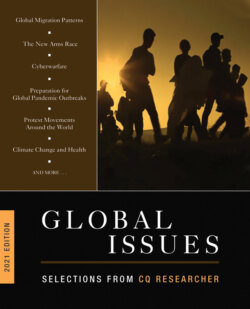Читать книгу Global Issues 2021 Edition - Группа авторов - Страница 39
At Issue
ОглавлениеWill U.S. sanctions force Iran to the negotiating table?
Yes
Djavad Salehi-Isfahani
Professor of Economics, Virginia Tech
Written for CQ Researcher, November 2019
Since May 2018, Iran’s economy has taken a serious beating due to U.S. sanctions. After contracting by 4.9 percent in 2018, Iran’s economy will contract by 9.5 percent this year, according to the International Monetary Fund. Since 2012, sanctions have cost a total of about half a trillion U.S. dollars, nearly the same as Iran’s GDP.
Iranian leaders are under increasing pressure to restore economic growth. But they believe the Trump administration’s primary objective is Iran’s capitulation or regime change, and the leadership is divided on the benefits from dialogue with the United States and on how badly Iran needs to end the sanctions.
Iran’s Supreme Leader, Ayatollah Ali Khamenei, who has been advocating a “resistance economy” for 10 years, sees proximity to the West as undermining Islamic values. He is optimistic that the economy can function with—and even benefit from—very low oil exports. Employment data for the first half of the Iranian year (March 21 to Sept. 20) support his optimism: About 800,000 more people are working in Iran now than when sanctions began in 2018, and the unemployment rate has dropped by 2 percentage points.
The jump in jobs and output is not surprising, because the economy has unused capacity that is being used to replace imports. Devaluation in 2018 also raised average prices of imported goods by 2 to 3 times, making local production more profitable. But such recovery has its limits.
Pressure from U.S. sanctions is unlikely to abate, at least not until 2021 and then only if Trump loses the 2020 election. Serious obstacles to long-term recovery remain. Investment as a share of GDP has declined, from about 20 percent in 2011 to about 14 percent in 2018. This level of investment is barely enough to keep up with depreciation of existing capital. Having lost its major source of revenue from oil, the government is unlikely to take the lead in an investment-fueled recovery. The equally cash-strapped private sector cannot count on much help from the banking system, which is still recovering from a decade-long crisis of insolvency.
Unless the government can overcome these challenges and the economy begins to bear fruit soon, pressures from the decade-long stagnation will strengthen those who argue for re-engaging with the West. But this may not be enough to bring Iran to renegotiate the nuclear deal anytime soon.
NO
Esfandyar Batmanghelidj
Founder, Bourse & Bazaar
Written for CQ Researcher, November 2019
The Trump administration has been adamant that its “maximum pressure” sanctions are bringing the Iranian economy to the brink of collapse. But even as the country grapples with the harsh realities of a 9.5 percent contraction in GDP in 2019, the pending recovery of the Iranian economy is easy to demonstrate across four basic datasets.
First, Iran’s foreign exchange market has stabilized. Since early May, the Iranian rial has regained around 30 percent of its value against the dollar. The value of the rial has remained stable after the Central Bank of Iran implemented new oversight systems, even as geopolitical tensions reached new highs this past summer.
Second, while inflation remains high and continues to erode the purchasing power of Iranian households, the recent recovery of the rial has seen inflation grow at the slowest pace since the reimposition of sanctions 18 months ago. The consumer price index rose at an annual rate of only 6.1 percent in September. As economist Djavad Salehi-Isfahani recently observed: “Price stability is necessary for economic recovery, and the trend in inflation is in the right direction for Iran.”
Third, Iran’s purchasing manager’s index, which measures whether the manufacturing sector is expanding or contracting, has exceeded 50 in five of the last seven months. An index greater than 50 reflects an expansion in manufacturing activity compared to the previous month. Iran’s assembly lines keep whirring, and Iran continues to produce goods for export.
Finally, Iran’s non-oil exports are projected to reach a record level this year—more than $40 billion—exceeding oil exports for the first time. Oil exports will be limited to around $10 billion in 2019 after the Trump administration revoked key sanctions waivers. The recourse to non-oil trade means Iran will continue to earn vital foreign currency, further reducing dependence on an oil industry that rarely accounted for more than 20 percent of Iran’s GDP.
In short, the harm the Trump administration has inflicted on so many Iranian households does not, in fact, equate to fundamental vulnerability in the Iranian economy.
Other analysts say Trump’s recent statement that the situation in Syria has “nothing to do with us” also sends the message to Saudi Arabia, Israel and other U.S. allies in the Middle East that Washington will no longer block Iran’s designs on the region.61
